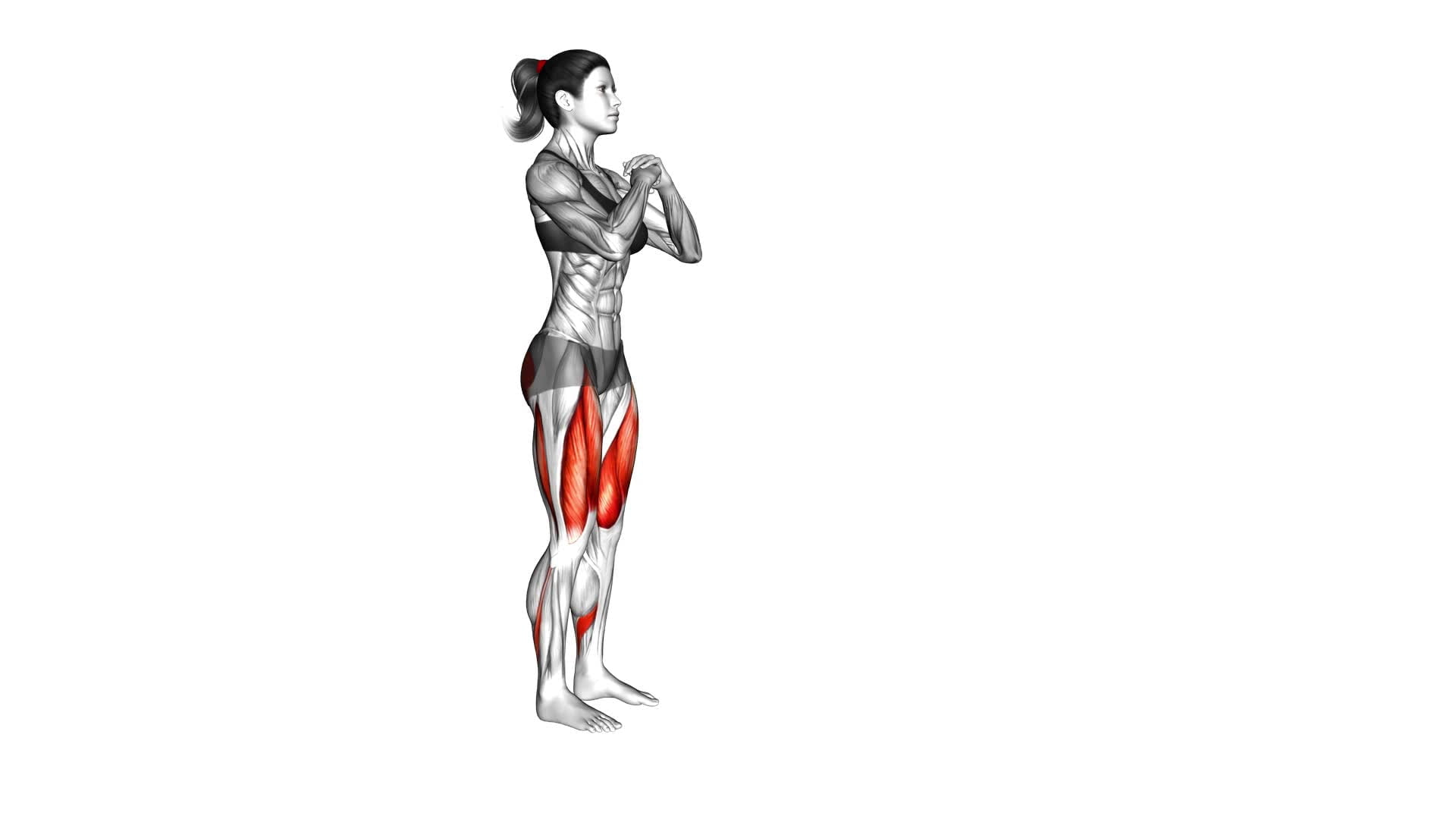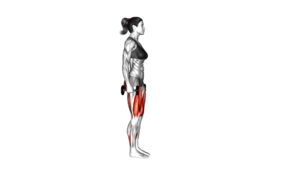Walking Lunge (female) – Video Exercise Guide & Tips

Are you a female looking to tone and strengthen your legs? Look no further than the walking lunge!
Watch This Exercise Video
This video exercise guide will show you the proper form and technique to maximize your results. Whether you're a beginner or more advanced, there are modifications and tips to suit your fitness level.
Grab some dumbbells or kettlebells for added resistance and avoid common mistakes.
Get ready to feel the burn and achieve those leg goals!
Let's get lunging!
Key Takeaways
- Walking lunges strengthen and tone the lower body muscles, including the quadriceps, hamstrings, glutes, and calves.
- They improve balance, stability, flexibility, and range of motion.
- Proper form and technique are important, including starting with feet hip-width apart, maintaining core engagement and a straight back, and stepping forward with the right foot while keeping the knee above the ankle.
- Beginners can modify the exercise by performing stationary lunges, taking smaller steps, and focusing on proper form and technique.
Benefits of Walking Lunges for Females
Experience the numerous benefits of walking lunges for females, from strengthening your lower body to improving balance and flexibility. Incorporating walking lunges into your fitness routine can have a significant impact on your overall health and well-being.
When it comes to female fitness benefits, walking lunges are a powerhouse exercise. They target multiple muscle groups simultaneously, including your quadriceps, hamstrings, glutes, and calves. This compound movement not only strengthens your lower body but also helps to tone and sculpt your legs and buttocks.
Walking lunges also offer a great way to improve your balance and stability. As you step forward into each lunge, you engage your core muscles, forcing them to work harder to maintain your balance. This can be particularly beneficial for women, as it helps to strengthen the muscles that support your spine and improve your posture.
Furthermore, walking lunges can enhance your flexibility. The dynamic nature of this exercise requires a wide range of motion in your hips and knees, which can help to increase your overall flexibility and range of motion.
To maximize the benefits of walking lunges, try incorporating different variations into your routine. This can include adding weights, using a stability ball, or performing walking lunges on an incline. These variations can help to increase the intensity of the exercise and target different muscle groups.
In summary, walking lunges offer a wide range of benefits for females, including strengthening the lower body, improving balance and stability, and enhancing flexibility. By incorporating different variations into your routine, you can take your fitness to the next level and achieve even greater results.
Proper Form and Technique for Walking Lunges
To perform walking lunges with proper form and technique, follow these steps.
- Start by standing with your feet hip-width apart and your hands on your hips or by your sides.
- Take a step forward with your right foot, ensuring that your knee is directly above your ankle.
- Lower your body until your right thigh is parallel to the ground, and your left knee is almost touching the ground.
- Push through your right heel to return to the starting position, and repeat on the opposite side.
- Keep your core engaged and your back straight throughout the movement.
- It's crucial to avoid allowing your front knee to extend past your toes or collapsing your chest.
By practicing proper form and technique, you can maximize the benefits of walking lunges while reducing the risk of injuries.
Walking lunges offer numerous benefits for women, such as strengthening the lower body muscles, improving balance, and increasing flexibility.
To prevent injuries during walking lunges, it's important to maintain proper form.
Now, let's explore modifications for beginners to gradually build strength and endurance.
Modifications for Beginners
To make walking lunges more accessible for beginners, you can incorporate modifications that gradually build strength and endurance. As a beginner, it's important to focus on proper form and technique before progressing to more advanced variations. One modification you can try is performing stationary lunges instead of walking lunges. This allows you to focus on mastering the movement without the added challenge of walking forward. Another modification is to reduce the range of motion by taking smaller steps. This can help you maintain balance and stability while still engaging the muscles effectively.
Common mistakes that beginners often make include leaning too far forward, allowing the knee to extend beyond the toes, and not fully engaging the glutes and hamstrings. To prevent these mistakes, remember to keep your torso upright, your knee in line with your ankle, and squeeze your glutes as you push back to the starting position.
Adding Resistance: Using Dumbbells or Kettlebells
Using dumbbells or kettlebells can add resistance to your walking lunges, making them more challenging and effective for building strength and endurance. When it comes to choosing between dumbbells and kettlebells, both options have their benefits.
Dumbbells provide a more stable grip, allowing for better control during the exercise. They also allow for a wide range of weight options, making it easier to progress as you get stronger.
On the other hand, kettlebells have a unique shape that challenges your grip and engages more muscles in your upper body. They also promote a more dynamic and explosive movement, which can enhance your power and overall athleticism.
Adding resistance to your walking lunges through dumbbells or kettlebells can bring numerous benefits. Resistance training not only helps to increase your muscle strength and endurance but also boosts your metabolism, leading to improved fat loss and body composition. It also enhances bone density, reduces the risk of injury, and improves overall functional fitness.
Now that you understand the benefits of adding resistance to your walking lunges, it's time to address common mistakes to avoid to ensure you get the most out of this exercise.
Common Mistakes to Avoid
To ensure you get the most out of your walking lunges and avoid potential injuries, it's important to focus on proper form and injury prevention techniques.
Keep your core engaged and maintain a straight back throughout the exercise to protect your spine.
Additionally, be mindful of your knee alignment, making sure they track in line with your toes to prevent strain or discomfort.
Proper Form Tips
Maintain proper form by keeping your back straight and engaging your core while performing walking lunges. This is crucial for injury prevention and maximizing the effectiveness of the exercise. By keeping your back straight, you ensure that your spine is properly aligned, reducing the risk of strain or injury. Engaging your core helps stabilize your body and maintain balance throughout the movement.
Additionally, focus on taking long strides and bending your front knee to a 90-degree angle, ensuring that your knee doesn't extend past your toes. By following these proper form tips, you won't only maximize the benefits of walking lunges but also reduce the risk of injury.
Now let's move on to discuss some injury prevention techniques that can further enhance your workout.
Injury Prevention Techniques
To prevent injuries while performing walking lunges, focus on properly aligning your body and avoiding common mistakes. One of the most important injury prevention techniques is maintaining proper form throughout the exercise. Keep your chest lifted, shoulders back, and core engaged to ensure proper alignment and stability.
Avoid leaning too far forward or backward, as this can put unnecessary strain on your knees and lower back. Another common mistake to avoid is rushing through the exercise. Take your time with each lunge, ensuring that your front knee stays in line with your ankle and doesn't extend past your toes.
Tips for Maximizing the Effectiveness of Walking Lunges
To maximize the effectiveness of your walking lunges, it's crucial to focus on maintaining proper form and technique. Keep your core engaged, chest up, and step forward with a long stride to engage your glutes and quads effectively.
Additionally, to challenge yourself further, you can add resistance by holding dumbbells or using a weighted vest.
Lastly, incorporating variations like lateral lunges or walking lunges with a twist can help add variety to your workout routine and target different muscle groups.
Proper Form and Technique
By maintaining a strong upright posture, you can maximize the effectiveness of your walking lunges. Proper form and technique are crucial for injury prevention and maximizing the effectiveness of this exercise.
Start by standing tall with your feet hip-width apart. Take a step forward with your right leg, lowering your body until both knees are at a 90-degree angle. Keep your core engaged and your chest lifted throughout the movement.
Push through your front heel and bring your back leg forward to continue walking. Avoid leaning forward or letting your knees collapse inward. Focus on keeping your weight evenly distributed between both legs.
Adding Resistance for Challenge
To maximize the effectiveness of your walking lunges and add a challenge, you can incorporate resistance into the exercise. Here are three ways to do it:
- Resistance Bands: Attach a resistance band around your thighs or ankles to increase the difficulty of the movement. The bands provide constant tension, targeting your muscles even more.
- Weighted Vest: Wear a weighted vest while performing walking lunges to add extra resistance and increase the intensity of the exercise. This will make your muscles work harder and help build strength.
- Dumbbells or Kettlebells: Hold a pair of dumbbells or kettlebells in your hands to add resistance to your walking lunges. This will make your lower body muscles work harder and enhance the challenge.
Incorporating Variations for Variety
To maximize the effectiveness of your walking lunges and add variety, incorporate different variations of the exercise.
By incorporating equipment such as dumbbells or resistance bands, you can increase the intensity and challenge your muscles in new ways. Holding dumbbells at your sides or placing a resistance band around your thighs can provide added resistance, helping to build strength and tone your lower body.
Additionally, you can try advanced modifications like lateral lunges, where you step out to the side instead of forward, or reverse lunges, where you step back instead of forward. These variations target different muscles and engage your body in different planes of motion, keeping your workouts fresh and effective.
Don't be afraid to experiment and push yourself to try new variations for maximum results.
Frequently Asked Questions
How Many Repetitions Should I Do for Walking Lunges?
When it comes to walking lunges, the number of repetitions you should do depends on your fitness level and goals.
Walking lunges with weights are a great way to challenge your lower body and build strength.
To properly perform walking lunges, start with your feet hip-width apart, take a step forward, and lower your back knee towards the ground.
Keep your core engaged and push through your front heel to stand back up.
Incorporate walking lunges into your workout routine and aim for 8-12 repetitions per set for optimal results.
Keep pushing yourself and you'll see progress!
Can Walking Lunges Help Improve My Balance and Stability?
Walking lunges are a great exercise for improving balance and stability. By incorporating walking lunge variations into your workout routine, you can challenge your core muscles and improve your overall stability.
This exercise is especially beneficial for athletes, as it helps to strengthen the leg muscles, increase hip flexibility, and enhance proprioception.
Incorporating walking lunges into your training can help you perform better in sports and reduce the risk of injuries.
Keep pushing yourself and reap the benefits!
Are There Any Alternatives to Walking Lunges for Targeting the Same Muscle Groups?
Looking for alternatives to walking lunges?
There are several exercises that can target the same muscle groups. Try reverse lunges, static lunges, or Bulgarian split squats. These exercises can help strengthen your lower body and improve balance and stability just like walking lunges.
By incorporating these alternatives into your workout routine, you can maximize the benefits and keep your workouts interesting and effective.
Is It Necessary to Warm up Before Performing Walking Lunges?
Before performing walking lunges, it's important to warm up to prevent injury and maximize the effectiveness of the exercise.
Stretching is crucial to loosen up your muscles and increase flexibility.
Avoid common mistakes like leaning too far forward or allowing your knees to extend past your toes.
Stay focused and maintain proper form throughout the movement.
Can Walking Lunges Help With Weight Loss and Toning the Legs?
Walking lunges are a great exercise for weight loss and toning your legs. By incorporating this exercise into your routine, you can burn calories and build lean muscle.
To do walking lunges correctly, start by taking a big step forward with one leg, lowering your body until both knees are bent at a 90-degree angle. Push off with your front leg and repeat with the other leg.
Keep going and feel the burn!
Conclusion
Walking lunges are a fantastic exercise for females to tone and strengthen their lower body. By following proper form and technique, beginners can modify the exercise to suit their fitness level. Adding resistance with dumbbells or kettlebells can further enhance the benefits.
It's important to avoid common mistakes and maximize the effectiveness of walking lunges by staying focused and pushing through the burn. So grab your workout gear and get ready to take your fitness to the next level with walking lunges!

Author
Years ago, the spark of my life’s passion ignited in my mind the moment I stepped into the local gym for the first time. The inaugural bead of perspiration, the initial endeavor, the very first surge of endorphins, and a sense of pride that washed over me post-workout marked the beginning of my deep-seated interest in strength sports, fitness, and sports nutrition. This very curiosity blossomed rapidly into a profound fascination, propelling me to earn a Master’s degree in Physical Education from the Academy of Physical Education in Krakow, followed by a Sports Manager diploma from the Jagiellonian University. My journey of growth led me to gain more specialized qualifications, such as being a certified personal trainer with a focus on sports dietetics, a lifeguard, and an instructor for wellness and corrective gymnastics. Theoretical knowledge paired seamlessly with practical experience, reinforcing my belief that the transformation of individuals under my guidance was also a reflection of my personal growth. This belief holds true even today. Each day, I strive to push the boundaries and explore new realms. These realms gently elevate me to greater heights. The unique combination of passion for my field and the continuous quest for growth fuels my drive to break new ground.







